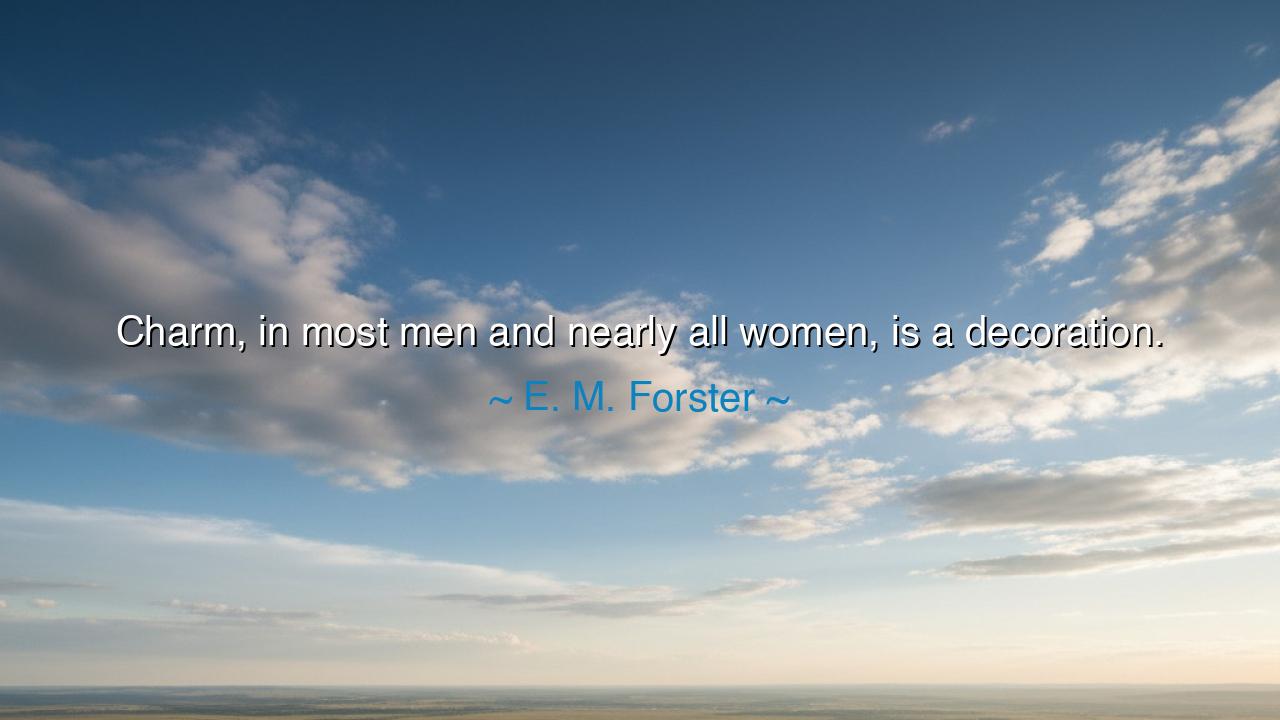
Charm, in most men and nearly all women, is a decoration.






Hear the sharp and subtle wisdom of E. M. Forster: “Charm, in most men and nearly all women, is a decoration.” In this saying, he unveils the truth that charm is often not the essence of a soul, but an ornament placed upon it. Like gold upon wood, or paint upon stone, it may dazzle the eye yet conceal the substance beneath. The heart of the teaching is this: judge not by decoration, but by the foundation, for a house of marble pillars is stronger than a hut draped in silk.
The ancients knew of this duality. In Athens, Alcibiades was famed for his beauty, wit, and charm, yet beneath the glittering exterior lay ambition and treachery. His decoration swayed the people for a time, but in the end, his lack of steadfastness brought ruin upon himself and sorrow upon his city. Thus, Forster warns that to mistake charm for character is to be deceived, for charm may delight, but it does not endure when the storms of fate descend.
Consider, too, the example of Cleopatra. Her charm was legend, her voice and presence able to bend the wills of mighty men. Yet it was not mere decoration; for beneath the ornament lay sharp intellect, keen strategy, and unyielding ambition. In her case, the decoration was not hollow, but woven into substance. Here lies the deeper wisdom of Forster’s words: that when charm is mere surface, it is fleeting, but when it is joined to depth, it becomes a force that can shape empires.
The saying also holds a mirror to society, which often weighs women especially by their decoration—their charm, beauty, or grace—rather than their wisdom or power. Forster, in his keen observation, calls out this pattern, showing that what many exalt is but ornament, distracting from the deeper worth within. To see only charm is to see only the petals of the flower, forgetting the roots that give it life.
So let the generations remember: charm can delight, it can open doors, it can soften hearts. But it is not the pillar of character. It is the decoration, not the foundation. Seek the stone beneath the paint, the steel beneath the glitter, the truth beneath the smile. For in the end, when time strips away all ornaments, only substance remains.






AAi
Forster’s view of charm as a mere decoration might reflect his cynicism about human nature. But could it also imply that charm is something that often hides deeper qualities? Is charm just a surface-level trait, or does it act as a gateway to reveal more about a person? I’m curious how much weight we should give to charm in determining someone’s character—can it really be reduced to just an accessory?
GDGold D.dragon
This quote raises a fascinating point about charm’s role in society. If charm is merely a 'decoration,' does that mean it’s not significant in building relationships or creating connections? Is charm only valued because of its aesthetic appeal, or does it convey something deeper about how we present ourselves to others? I wonder if Forster is criticizing the overemphasis on charm, especially when it detracts from more substantial qualities.
MAVu Minh Anh
I can see how Forster might think of charm as a decoration, especially in a society that often places undue importance on physical or superficial traits. However, I wonder if this perspective oversimplifies the role of charm in shaping a person’s interactions and relationships. Is charm merely a tool for manipulation, or can it also reflect genuine warmth and appeal? Perhaps it’s both, depending on context.
BNpham bich ngoc
I think Forster’s statement about charm being a 'decoration' could be viewed as a commentary on societal expectations. Often, charm in women is highly emphasized as an essential quality, sometimes more than other traits like intelligence or creativity. Is charm really just a surface-level trait, or does it serve as a tool for navigating social dynamics? I wonder if Forster’s view dismisses the strategic role charm can play in professional or social settings.
-127 - Thanh Nga - 12A4
This quote seems to suggest that charm is more of a superficial trait, something that just 'decorates' a person. But what if charm is a reflection of something deeper, like confidence or kindness? Should charm be dismissed as just a decoration, or is it a vital part of human interaction, especially in how we influence and connect with others? I feel like the role of charm might be more complex than Forster gives it credit for.